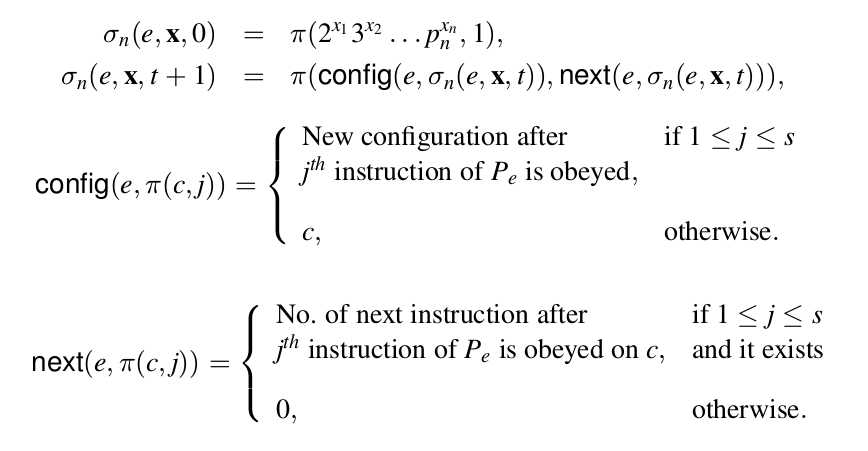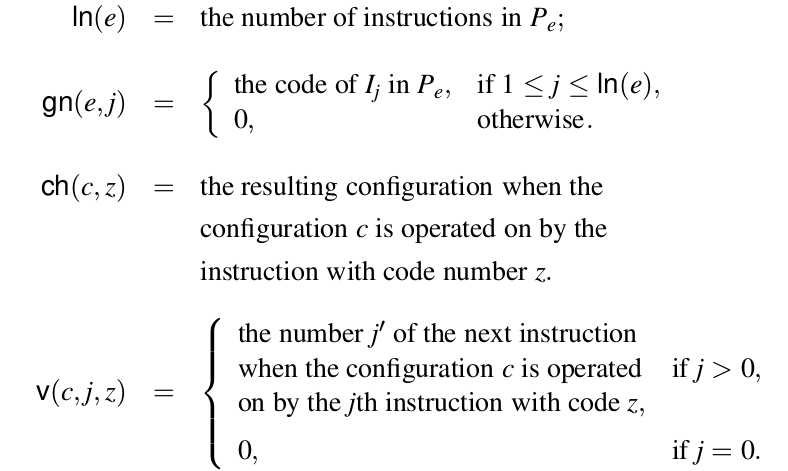标签:
The Universal Function for n-ary computable functions is the (n+1)-ary function:
![]()
Theorem. For each n, the universal function ΨU is computable.
============================================================================================
To avoid using Church‘s Thesis, we prove this theorem step by step in a top-down way as the following sketch.
Step 1. The configuration of the registers can be coded as c = Π piri, where pi is the ith prime, and given the number of the next instruction j we can encode the current computation state as σ = π(c,j). To prove the universal functions are computable, we should prove no further than cn(e,x,t) and jn(e,x,t) are computable since:
![]()
And we can prove that by proving the following function is a primitive recursive function (a stronger conclusion):
![]()
Step 2. From another perspective, σn can be defined as follow:

Hence, we need to prove config and next are primitive recursive functions.
Step 3. We further define the following auxillary functions:

And we should prove the functions above are primitive recursive due to the following facts:

![]()
Step 4. To prove In, gn, ch and v are primitive recursive functions, we should resort to the definitions of program code nunber and instruction code number. Here, I shall omit further details of the proof of this step.
P.S. 虽然讲了整整一节课,但这个证明跟当年的递归定理比起来简直弱爆了~
========================================================================================
Corollary 1. For each n, the following predicates are decidable:
(1) Sn(e,x,y,t) defined as Pe(x) converges to y in t or fewer steps;
(2) Hn(e,x,t) defined as Pe(x) converges in t or fewer steps.
Corollary 2. (Kleene‘s normal form theorem) There is a total computable function U(x) and a decidable predicate Tn(e,x,z) such that:

As a matter of fact, every computable function can be obtained from primitive recursive functions by using at most one application of the unbounded minimalisation.
========================================================================================
Application 1. The problem ‘Φx is total‘ is undecidable.
To see this, we can construct a unary function defined by cases based on this predicate, which is other than any Φe(x) for any e by using Cantor‘s Diagonal Argument.
Application 2. There is a total computable function that is not primitive recursive.
Here, we provide a proof sketch:

Application 3. (Effectiveness of Production)
There is a total computable function s(x,y) such that Φs(x,y) = Φx Φy for all x and y.
Application 4. (Effectiveness of Inverse)
There is a computable function such that:
1. g(x,y) is defined if and only if y ∈ Ex, and
2. if y ∈ Ex, then g(x,y)∈ Wx and Φx(g(x,y)) = y.
Application 5. (Effectiveness of Recursion)
Consider function f defined by the following recursion:
![]()
![]()
There is a total computable function r(e1,e2) such that:
![]()
References:
1. Cutland, Nigel. Computability: an introduction to recursive function theory[M]. Cambridge: Cambridge University Press, 1980
标签:
原文地址:http://www.cnblogs.com/DevinZ/p/4430229.html